Difference between revisions of "Silica in Poaceae"
(→Arundinaria gigantea) |
(→Low-silica grasses for Armyworms) |
||
| Line 43: | Line 43: | ||
Exposure to silica-rich diets also caused an extremely rapid increased mandible wear.[http://www.ncbi.nlm.nih.gov/pubmed/18771503] This results in mechanical protection of resources in chlorenchyma cells. As a result of this (and of the disrupting influence of phytoliths on microbial action in the gut), less chlorophyll is released after grinding and more chlorophyll is retained after passing through the gut.[http://aob.oxfordjournals.org/content/102/4/653.full] | Exposure to silica-rich diets also caused an extremely rapid increased mandible wear.[http://www.ncbi.nlm.nih.gov/pubmed/18771503] This results in mechanical protection of resources in chlorenchyma cells. As a result of this (and of the disrupting influence of phytoliths on microbial action in the gut), less chlorophyll is released after grinding and more chlorophyll is retained after passing through the gut.[http://aob.oxfordjournals.org/content/102/4/653.full] | ||
| − | Low silica grasses/sedges are Agrostis scabra (Ticklegrass, a tumbleweed), Anthoxanthum odoratum (Vanilla grass in Eurasia), Arrhenatherum elatius (tall oatgrass in temperate Europe), Carex aquatilis (arctic and temperate water sedge), Carex flavicans, Carex subspathacea, Chasmanthium sessiliflorum (longleaf woodoats in temperate USA), Cymbopogon citratus (lemon grass in South-east Asia), Cyperus alopecuroides (aquatic tropical/temperate sedge), Dactylis glomerata {a cool-season perennial C3 bunchgrass), Juncus roemerianus (black needlerush in salt marshes and estuaries), Puccinellia phryganodes (arctic and temperate saltgrass), Scirpus tabernaemontani (temperate grassweed), Spartina alterniflora (Smooth Cordgrass in estuarine salt marshes), Spartina patens (saltmeadow cordgrass in brackish coastal marshes), Sporobolus cryptandrus (Sand dropseed in prairie), Stipa comata (needle/feather grass in savanna/prairie), Triticosecale spp.(Triticale, a wheat hybrid), Zea mays (maize), Zoysia japonica (creeping grass in temperate regions) and Setaria sphacelata (South African pigeon grass aka African bristlegrass aka Golden millet).[http://aob.oxfordjournals.org/content/96/6/1027/T1.expansion.html] | + | Low silica grasses/sedges are Agrostis scabra (Ticklegrass, a tumbleweed ; 0.3% silica), Anthoxanthum odoratum (0.6% ; Vanilla grass in Eurasia), Arrhenatherum elatius (0.9% ; tall oatgrass in temperate Europe), Carex aquatilis (arctic and temperate water sedge), Carex flavicans, Carex subspathacea, Chasmanthium sessiliflorum (0.7% ; longleaf woodoats in temperate USA), Cymbopogon citratus (0.8% ; lemon grass in South-east Asia), Cyperus alopecuroides (aquatic tropical/temperate sedge), Dactylis glomerata {0.6% ; a cool-season perennial C3 bunchgrass), Juncus roemerianus (0.2% ; black needlerush in salt marshes and estuaries), Puccinellia phryganodes (arctic and temperate saltgrass), Scirpus tabernaemontani (0.1% ; temperate grassweed), Spartina alterniflora (0.7% ; Smooth Cordgrass in estuarine salt marshes), Spartina patens (0.8% ; saltmeadow cordgrass in brackish coastal marshes), Sporobolus cryptandrus (0.7% ; Sand dropseed in prairie), Stipa comata (0.7% ; needle/feather grass in savanna/prairie), Triticosecale spp.(0.1% ; Triticale, a wheat hybrid), Zea mays (maize), Zoysia japonica (0.3% ; creeping grass in temperate regions) and Setaria sphacelata (South African pigeon grass aka African bristlegrass aka Golden millet).[http://aob.oxfordjournals.org/content/96/6/1027/T1.expansion.html] |
Grasses that utilize water more efficiently, have lower silica contents. As a result, perennial C4 grasses such as Prairie cordgrass (Spartina pectinata), Switchgrass (Panicum virgatum), Big bluestem (Andropogon gerardii) and Prairie sandreed (Calamovilfa longifolia) contain relatively little silica. [http://www.reap-canada.com/online_library/feedstock_biomass/24%20Strategies%20to.pdf]Panicum coloratum (White buffalograss; a medium-high grass) may contain 1.21% silica.[http://www.pnas.org/content/80/3/790.full.pdf] It is drought-tolerant and does well in hot climates. Other perennial C4 grasses are Yellow Indiangrass (Sorghastrum nutans) and Bermudagrass. | Grasses that utilize water more efficiently, have lower silica contents. As a result, perennial C4 grasses such as Prairie cordgrass (Spartina pectinata), Switchgrass (Panicum virgatum), Big bluestem (Andropogon gerardii) and Prairie sandreed (Calamovilfa longifolia) contain relatively little silica. [http://www.reap-canada.com/online_library/feedstock_biomass/24%20Strategies%20to.pdf]Panicum coloratum (White buffalograss; a medium-high grass) may contain 1.21% silica.[http://www.pnas.org/content/80/3/790.full.pdf] It is drought-tolerant and does well in hot climates. Other perennial C4 grasses are Yellow Indiangrass (Sorghastrum nutans) and Bermudagrass. | ||
Revision as of 14:27, 2 December 2014
Contents
Silicon for algae
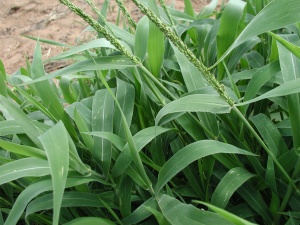

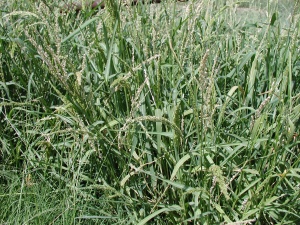
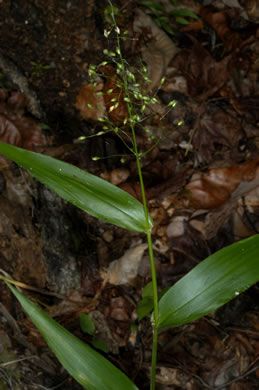
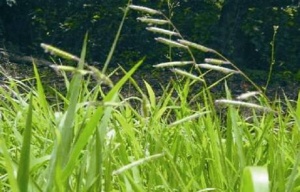
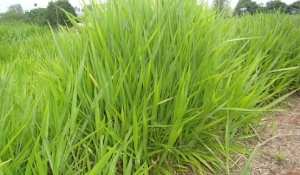
Tilapia naturally thrive on diatoms and Spirulina, which are algae. Diatoms that thrive in saline, alkaline conditions generally require high silicon:phosphorus ratios, including Anomoeoneis sphaerophora, Rhopalodia species, Nitzschia species and Synedra ulna. Compost may be used for supplying nutrients for the cultivation of Spirulina and diatoms. Compost may be derived from composting toilets. Such composting toilets frequently need the addition of dried plant material (sawdust, dried grasses or -leaves) as a carbon source. To add silicon along with the carbon, that plant material should be silicon accumulating. Silicon is the second most abundant element in soil.
Silica in plants
Plants may take up silicon from the soil if the pH is below 9. Biogenic silica is known to alleviate plant stressors such as high temperatures and drought.[9] There may be no relationship between soil type and plant Si concentrations, but with temperature and precipitation.[10] Water use per biomasse is lowest in regions with a high rainfall to evaporation ratio. Silicification in non-grass species is probably less dependent on soil silica availability [11] and water availability.[12].
Grasses
Leaf silica concentration in tall grass species increases with watering [13] and with age.[14] Blade silica content is higher after the grass has been defoliated.[15] Silica levels are lowest in the stem fraction. The level of silica in grasses may co-depend on the level of silica in the soil, availability of water [16], the pH of the soil and temperature. Grasses adapted to hot climates and atmospheres low in carbon dioxide (C4 grasses), usually have lower silica contents than C3 grasses (cool-season grasses). There is no consistent relationship berrveen silica content and annual precipitation.[17] Grasses may also solubilize silicate from clay. [18] In perennial grasses, the main source of silica is from monosilicic acid (soluble silica) in the water. Silica levels in grasses are highly influenced by the monosilicic acid contents of the soil. As a result, clay soils result in higher silica contents in grasses than sand.[19]
Wheat (Triticum spp.) are grass species and may contain 0.3 to 10% silicon.[20] Triticum aestivum may contain 2.5%, Triticum boeoticum 2.5%, Triticum dicoccoides 1.2% and Triticum percicumx 1.6% silica. Rice (Oryza sativa) may contain 4.2% silica. [21] Pennisetum purpureum (Elephant grass) may contain 0.85% silica [22]
Brachiaria
Brachiaria species ('Signal grass') are C4 ('Millet') grasses that grow fast.[23] Brachiaria brizantha may contain 1.38% silicon [24] Brachiaria brizantha adapts poorly to poorly drained soils.[25]
Particularly Brachiaria decumbens (aka Urochloa decumbens, aka Surinam grass / Signal grass) may be considered silicon accumulating (3.6% in adult leaves[26]) and resistant to droughts.[27] It occurs in Burundi, Rwanda, Democratic Republic of Congo, Kenia, Tanzania and Uganda.[28] Silica levels in Brachiaria decumbens are highest in mature leaves, particularly on the upper epidermis of the grass leaf blades.[29] It may also grow in low fertilitiy, low pH (as low as pH 3.5) soil, while it does not respond to lime, but responds strongly to N and P fertiliser. It cannot persist on heavy clays subject to waterlogging, as its root system is very fine with low tolerance of poor drainage. Brachiaria decumbens stays green well into the dry season. It is most productive on open grasslands in the lowland humid tropics with rainfall >1,500 mm annually and a dry season of up to 5 months. It can tolerate short-term flooding and prefers temperatures above 19ºC. It is very tolerant of heavy grazing but less tolerant under reduced light than in full sun.[30]
Panicum
Panicum species ('Panic grass') are large tropical ('millet') grasses. Panicum maximum ('Buffalo grass') may contain 1.07% [31] or 0.5% silica.[32] Panicum virgatum ('Switch grass') may contain 1.5% [33] or 2.0% silica. Panicum commutatum may contain 4.2% and Panicum texanum may contain 8.0% silica [34] or 7%.[35] Panicum texanum (aka Brachiaria texana or Urochloa texana, aka Buffalo grass, Colorado grass, Texas signal grass or Texas millet) has up 2 cm wide leaves (7.5-28 cm long) that are covered with soft minute hairs on both surfaces. Its stems may be up to 136 cm long, and the grass may grow 80 cm high.[36] It is a common troublesome weed in many commercial crops. It may grow well at 30°C during the day and 24°C during the night. It may produce 53,000 seeds per plant.[37] (and therefore used by bird-enthusiasts[38]) It grows along streams, in open fields, on prairies and on deep moist soils, southern USA and Mexico. Both annual and perennial. It is used for hay.[39] It is best adapted to well-drained sandy soils, and usually produces 23,000 seeds per plant.[40] Vegetative stage Panicum texanum may contain 16% crude protein. It may contain 11% crude protein at flower/boot stage and 8% crude protein at fruit/head stage. Subsequent invitro dry matter digestibility may range from 74 to 52%.[41] Panicum texanum occurs in Queensland and New South Wales (Australia), Arizona, California. New Mexico, Texas. Alabama, Arkansas, Florida, Georgia, Louisiana and South Carolina (USA) and North-east Zacatecas (Mexico).[42]
Other Poaceae
Besides grasses, Pleioblastus chino 5.1% (a bamboo species) may contain 5.1% silica, Marchantia polymorpha (common liverwort or umbrella liverwort) may contain 5.5%, Eleocharis uniglumis (spikesedges in aquatic or mesic habitats) 6.7% and Arundinaria gigantea (also a bamboo species) 8.8% [43] Wetland Gramineae may accumulate up to 15% dry weight silica.[44]
Arundinaria gigantea
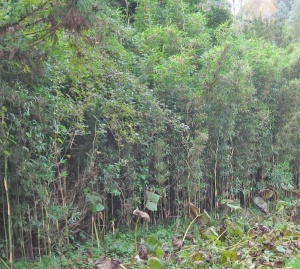
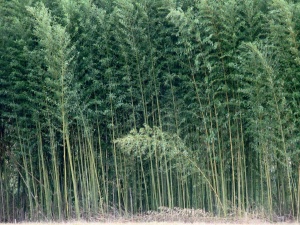
Arundinaria gigantea (aka Giant cane, River cane or Canebreak bamboo). Arundinaria gigantea var. tecta or Arundinaria tecta (Switch cane) is smaller and adapted to more aquatic conditions. [45]
Low-silica grasses for Armyworms
Armyworm eggs may be used to mass-rear green lacewings, and its pupa and young larvae to feed tilapia. High silica in grasses and sedges inhibits Armyworm growth. The addition of silicon to the soil increases the size, shape, number and density of spines and phytoliths in the leaves of grasses.[46] And when defoliated by herbivores, silicate contents may increase 4-fold in response [47], but not nearly so much in grasses clipped with scissors.[48][49] Particularly in Africa the effects of grazing on silica contents are great, but not the effects of burning by fire.[50] Silica is deposited as phytoliths in leaves. These are harder than tooth enamel.[51] Phytoliths may also disrupt microbial action in the gut.[52] Spodoptera exempta cannot easily adapt to physical defences such as silica. Silica in the leaves of grasses (2-5% of dry leaf mass [53]) acts as a defence. Even with short-term exposure, but also progressively impacting with time, silica reduces the conversion efficiency of food into bodymass, and the amount of nitrogen absorbed from their food, leading to reduced growth rates. Exposure to silica-rich diets also caused an extremely rapid increased mandible wear.[54] This results in mechanical protection of resources in chlorenchyma cells. As a result of this (and of the disrupting influence of phytoliths on microbial action in the gut), less chlorophyll is released after grinding and more chlorophyll is retained after passing through the gut.[55]
Low silica grasses/sedges are Agrostis scabra (Ticklegrass, a tumbleweed ; 0.3% silica), Anthoxanthum odoratum (0.6% ; Vanilla grass in Eurasia), Arrhenatherum elatius (0.9% ; tall oatgrass in temperate Europe), Carex aquatilis (arctic and temperate water sedge), Carex flavicans, Carex subspathacea, Chasmanthium sessiliflorum (0.7% ; longleaf woodoats in temperate USA), Cymbopogon citratus (0.8% ; lemon grass in South-east Asia), Cyperus alopecuroides (aquatic tropical/temperate sedge), Dactylis glomerata {0.6% ; a cool-season perennial C3 bunchgrass), Juncus roemerianus (0.2% ; black needlerush in salt marshes and estuaries), Puccinellia phryganodes (arctic and temperate saltgrass), Scirpus tabernaemontani (0.1% ; temperate grassweed), Spartina alterniflora (0.7% ; Smooth Cordgrass in estuarine salt marshes), Spartina patens (0.8% ; saltmeadow cordgrass in brackish coastal marshes), Sporobolus cryptandrus (0.7% ; Sand dropseed in prairie), Stipa comata (0.7% ; needle/feather grass in savanna/prairie), Triticosecale spp.(0.1% ; Triticale, a wheat hybrid), Zea mays (maize), Zoysia japonica (0.3% ; creeping grass in temperate regions) and Setaria sphacelata (South African pigeon grass aka African bristlegrass aka Golden millet).[56]
Grasses that utilize water more efficiently, have lower silica contents. As a result, perennial C4 grasses such as Prairie cordgrass (Spartina pectinata), Switchgrass (Panicum virgatum), Big bluestem (Andropogon gerardii) and Prairie sandreed (Calamovilfa longifolia) contain relatively little silica. [57]Panicum coloratum (White buffalograss; a medium-high grass) may contain 1.21% silica.[58] It is drought-tolerant and does well in hot climates. Other perennial C4 grasses are Yellow Indiangrass (Sorghastrum nutans) and Bermudagrass.
Cynodon dactylon

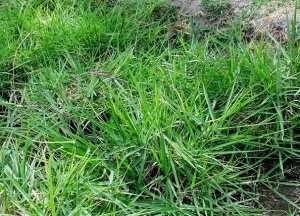

Bermuda grass (Cynodon dactylon) is also a perennial C4 grass. Grasses preferred by Armyworm larvae are sweet grasses in the genus Cynodon. [59] Bermuda grass is rare in Ghana, but abundant when present (up to 60 cm tall, does not tolerate shadow and prefers sandy, muddy and well drained soils. It is frequent in Mali, Ivory Coast and Nigeria. [60]. When supplemented, silica accumulation in Bermudagrass is high, but post-supplemental retention is low.[61] Silica contents in Bermudagrass may be 0.15% [62] or 1.5%.[63] Silica contents may be lower when the grass grows in sand, and higher when growing in clay.[64] The higher the nitrogen content of the leaves, the higher the Armyworm fecundity. In general, Armyworm fitness is hardly affected by leave nitrogen levels.[65] Net reproduction rate of Spodoptera exempta is greater on Bermuda grass (Cynodon dactylon) and maize than on Kikuyu grass, Pennisetum clandestinum, Guinea grass, Panicum maximum and Setaria plicatilis.[66][67] Larvae offered a choice of maize and Bermudagrass showed a preference for Bermudagrass. Survival was higher on Bermudagrass than on maize but the developmental time was longer.[68]
Bermuda grass may spread quickly via creeping stems (i.e. stolons and rhizomes).[69] Rhizomes (root-like stems) can penetrate 40-50 cm in clay soil and 70-80 cm in sand. It is foliage dense and 10-40 cm tall (rarely to 90 cm). Bermuda grass does best in relatively fertile, well-drained soils with pH over 5.5 with mean daily temperatures above 24°C (Optimum temperature for growth is 35°C[[70]]). It occurs over an average annual rainfall range of 625-1,750 mm, up to 4,300 mm. It is not shade tolerant. It is very drought tolerant by virtue of rhizome survival through drought-induced dormancy over periods of up to 7 months. Tolerates at least several weeks of deep flooding.[71]
Bermuda grass may be cut when 30-40 cm tall or every 4-6 weeks, usually when in full bloom. 4 cuttings per year are possible. A stubble height of 5-10 cm gives good regrowth and maintains sward density. Renovate by ploughing or discing when sod-bound. [72] Harvesting Bermuda grass at 4 weeks (close cut) increases crude protein in comparison with a 8-week cut. Crude protein varies from 8.3% in mature to 14% in young grass, up to 22% in nitrogen-fertilized grass. For protein production, nitrogen utilization from fertilizer (eg manure) begins to decline with 450 kg/ha. Dry matter may contain 1.1% oxalic acid. When sod-bound, renovate by ploughing or discing.[73]
Bermuda grass may be propagated by seed or vegetatively (turfs or stolon/rhizome pieces). Normally sown at 5-10 kg/ha dehulled seed, the higher rate being used for more rapid cover. Seed is best sown onto a very well prepared, fine, weed-free seedbed and rolled in. Seedlings usually root down quickly. Improved varieties are usually planted vegetatively due to low seed set or to avoid genetic drift. Turfs or sprigs can be planted at 3.5-7 m³/ha (40-80 bu/ac) or on a 90 cm (or less) grid, into a roughly or well-prepared seedbed, but rolling is still essential. Bermuda grass responds well to improved fertility, with applications of a minimum of 10 kg/ha/month N and up to 60 kg/ha/month N necessary for moderate to high productivity.[74]